Sourdough Discard Cinnamon Raisin Bread [makes perfect toast]
This post may contain affiliate links.
This sourdough discard cinnamon raisin bread is a joy to bake and eat. It will fill your kitchen with the most delightful aroma of baked cinnamon.
This loaf uses sourdough discard and a little yeast to help it rise, however if you would prefer to use only your active sourdough starter, you can definitely bake it that way. I've added instructions for both methods, as well as timelines for each so that you can make it the way that suits you and your sourdough starter.
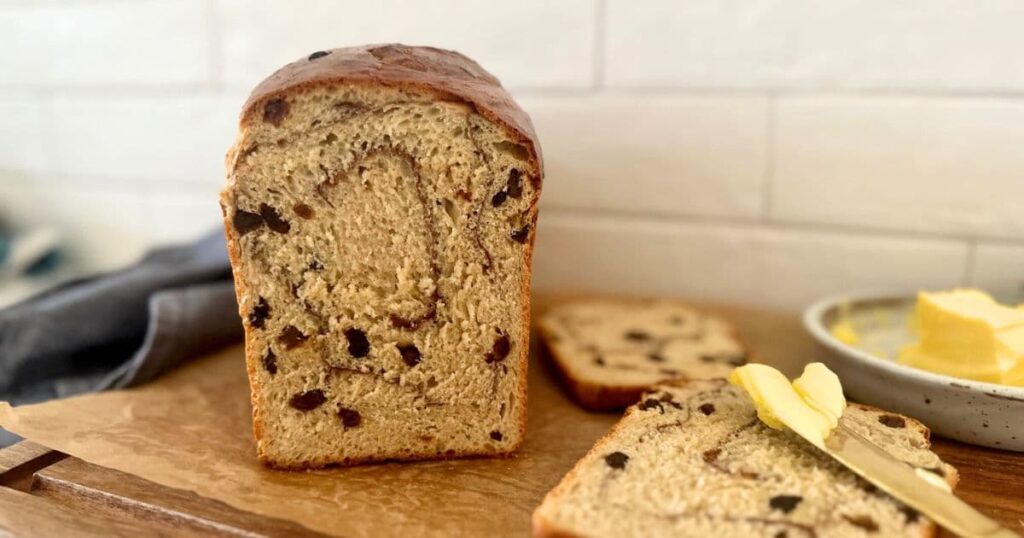
If you love the combination of cinnamon and raisin then why not try these cinnamon raisin sourdough bagels, these oatmeal raisin sourdough muffins or this walnut raisin sourdough bread. They are all delicious ways to use your sourdough starter in your next baking project! Oooh and don't forget these sourdough oatmeal raisin cookies!
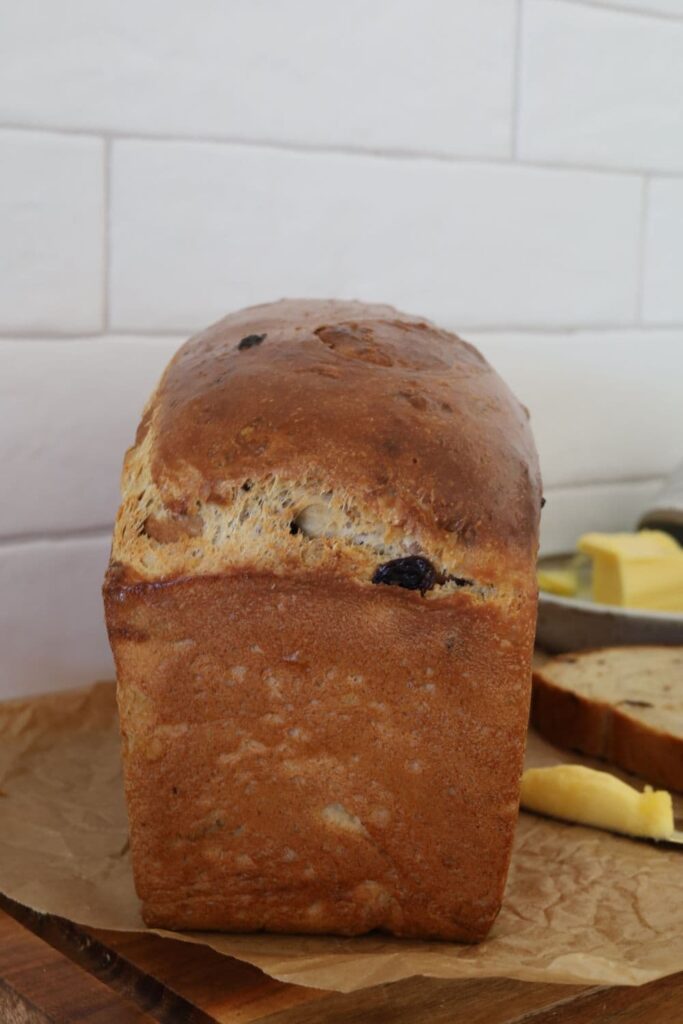
Why You'll Love This Recipe
No Fancy Shaping or Swirls - I've kept this loaf super easy, yet it's still bursting with cinnamon and raisins. It's so simple to add the cinnamon and shape, it's perfect for a beginner!
Versatile - You can use your sourdough discard plus yeast or your active starter, whatever suits your schedule and taste. I've added a timeline for both methods further down the page.
Makes Perfect Toast - this sourdough discard cinnamon raisin bread makes the most perfect toast. The brioche like dough turns a golden brown, while the inside stays deliciously soft and sweet. Smother it with homemade butter and enjoy! Or use leftovers in this sourdough bread pudding.
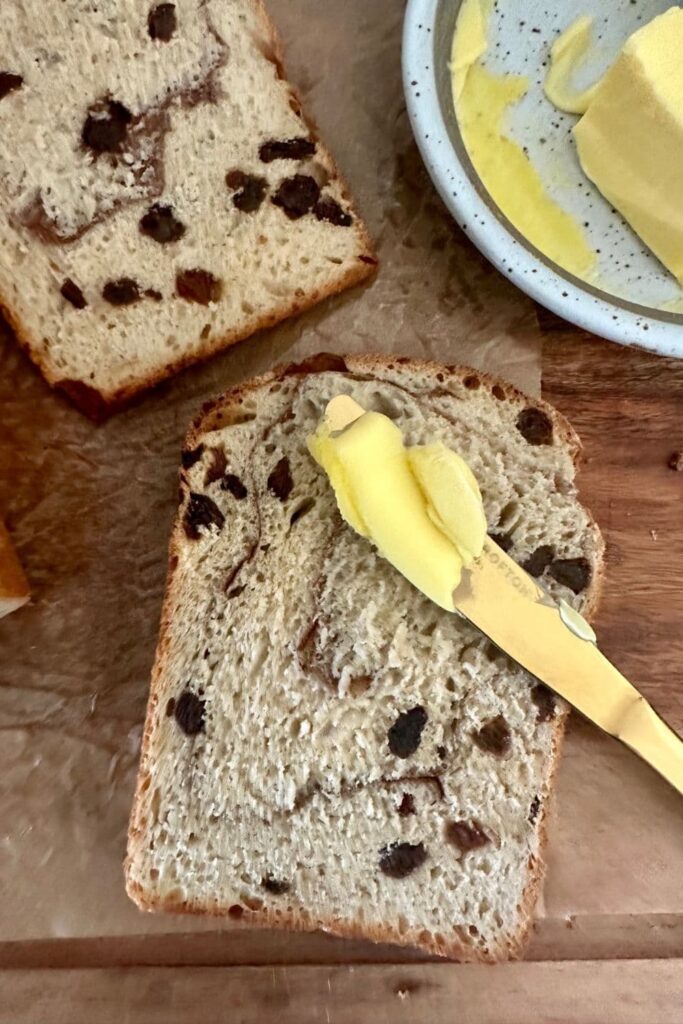
Why Use Your Sourdough Discard?
Sourdough discard is an important part of creating a thriving sourdough starter. When you begin your sourdough starter, you should not use your sourdough discard (the unfed starter you remove from the jar before each feeding) for at least 7 days (you can read more about sourdough discard here).
Once your starter is at least 7 days old, you can use your sourdough discard in a whole range of sourdough discard recipes. Sourdough discard cinnamon rolls, sourdough discard chocolate chip cookies and sourdough discard sandwich bread are all popular choices.
Many people love baking quick and easy no wait sourdough discard recipes with the unfed portion of their starter. It can be a fun way to manage the discard as you establish a healthy sourdough starter.
If you have a mature sourdough starter, you can use active starter as oppose to discard in any discard recipe, since it's all sourdough starter!
How To Make Sourdough Discard Cinnamon Raisin Bread
This sourdough discard cinnamon raisin bread has been through many iterations in my kitchen. It is based on my original sourdough discard sandwich bread which is the most popular recipe on my blog today.
Many loaves of this nature feature a "cinnamon raisin swirl or spiral" through the centre of the loaf. I have chosen not to do this as I don't find it's pleasant to eat. I much prefer the even distribution of raisins and cinnamon, especially when toasted. The method I've used in this discard loaf is similar to this sourdough cinnamon swirl loaf.
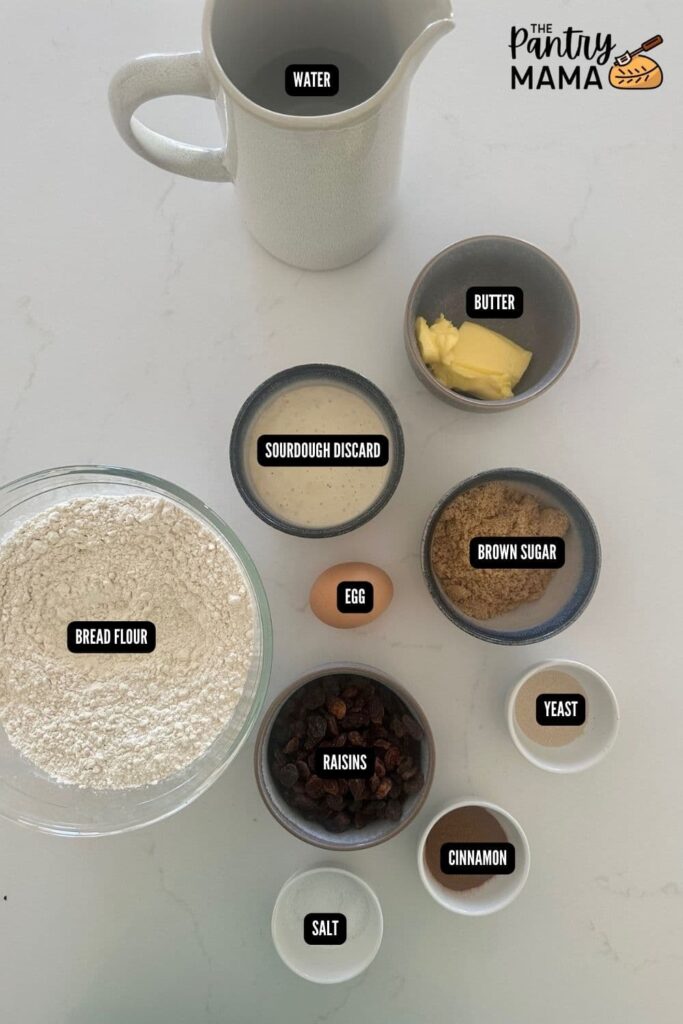
Mixing The Dough
I have written these instructions to make the dough by hand. It is a sticky dough when you add the butter, but it's totally doable by hand. You can definitely use a stand mixer if you prefer (I've added notes for this further down).
In a large bowl, whisk together sourdough discard, water, egg and brown sugar. Once it's well combined, add the yeast to the liquid and stir through (remember you don't have to add the yeast if you are using active sourdough starter).
Now add the bread flour and salt to the bowl and bring this together into a shaggy dough. Allow this to sit for around 30 minutes.
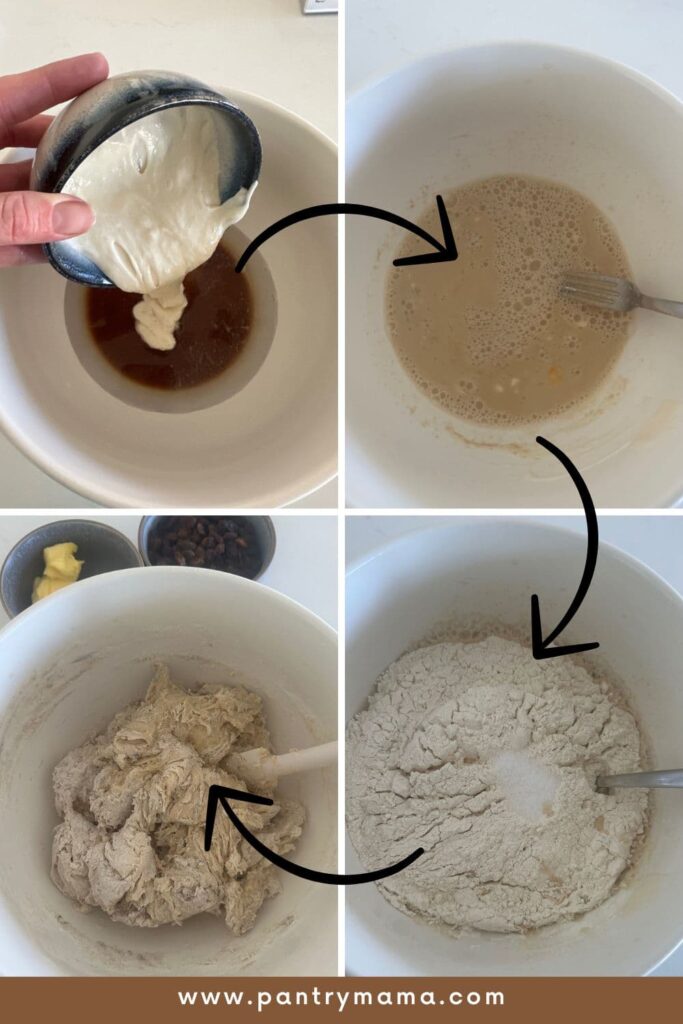
Kneading The Dough
Once the dough has been sitting for 30 minutes, tip it onto the counter and add a little of the soft butter on top of the shaggy dough.
Knead the dough until the butter has been distributed through, then add a little more butter until all the butter has been added.Don't worry if the dough feels slimy or too sticky. Keep kneading.
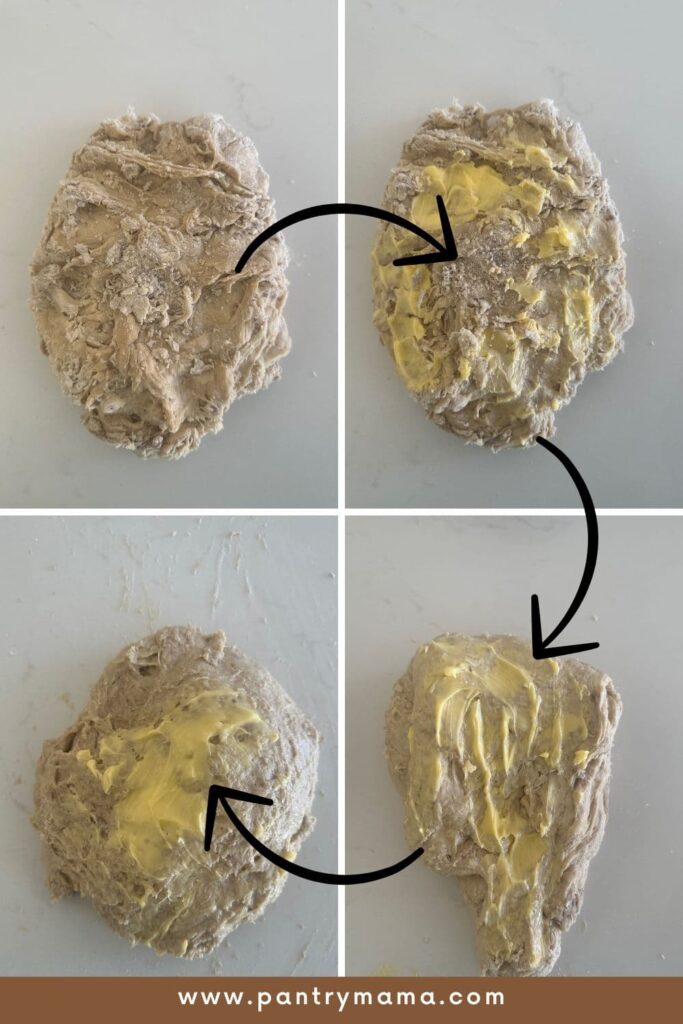
This dough is similar to a brioche dough in that it will get quite unworkable until you really push the butter into the dough. All of a sudden if will come together - I promise!
Once the butter has all been added, sprinkle the raisins through the dough as you continue to knead.
The dough will take around 10 minutes to knead by hand and will become silky and elastic.
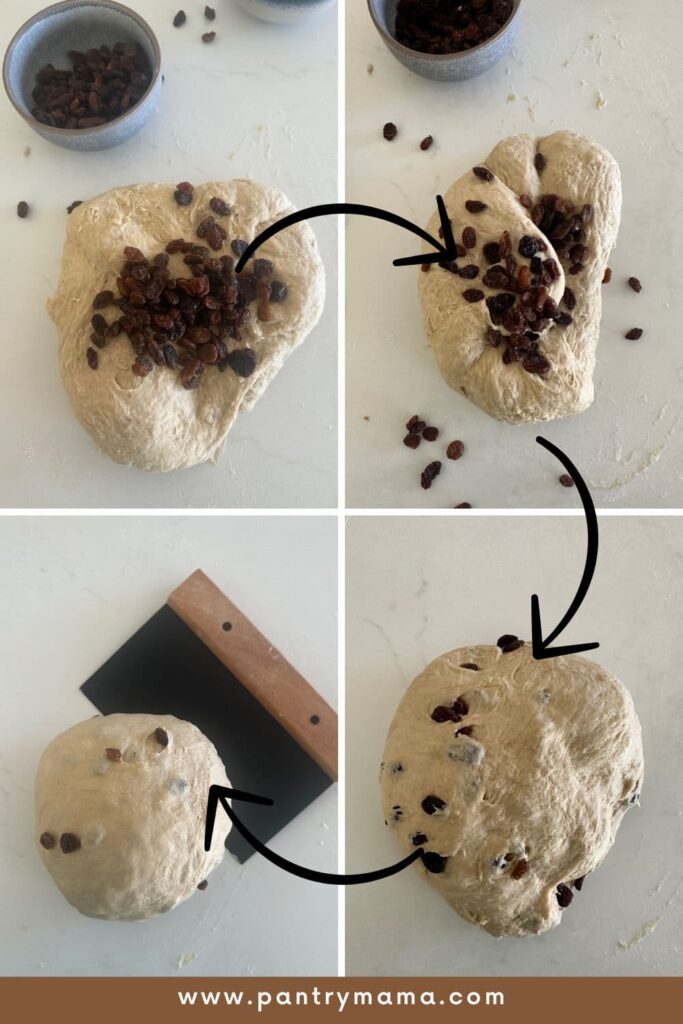
Bulk Fermentation
Once the dough has been sufficiently kneaded, place it into a bowl and cover with a plastic food cover. Allow the dough to double in the bowl before moving onto the next step. Because we've added a little commercial yeast, this won't take too long (I've added notes below in case you don't want to use yeast and want to use your active starter instead).
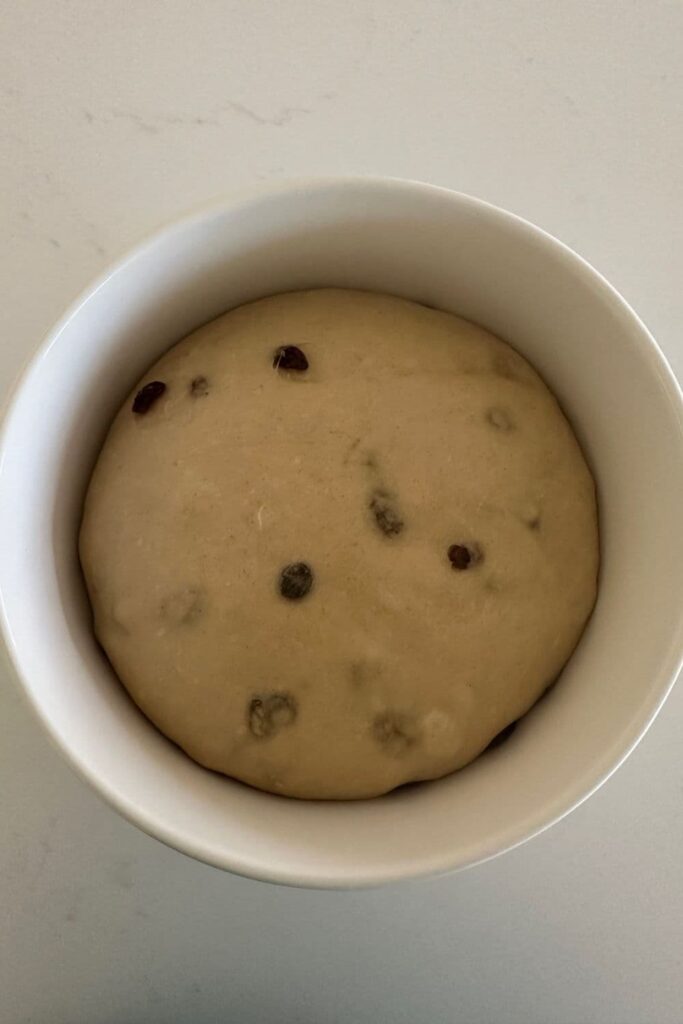
Shaping The Dough
Once the dough has doubled, tip it out onto the counter top with the smooth side underneath and the sticky side on the top. Gently ease the dough out into a rectangle. It should be quite easy to do this as the dough is very elastic.
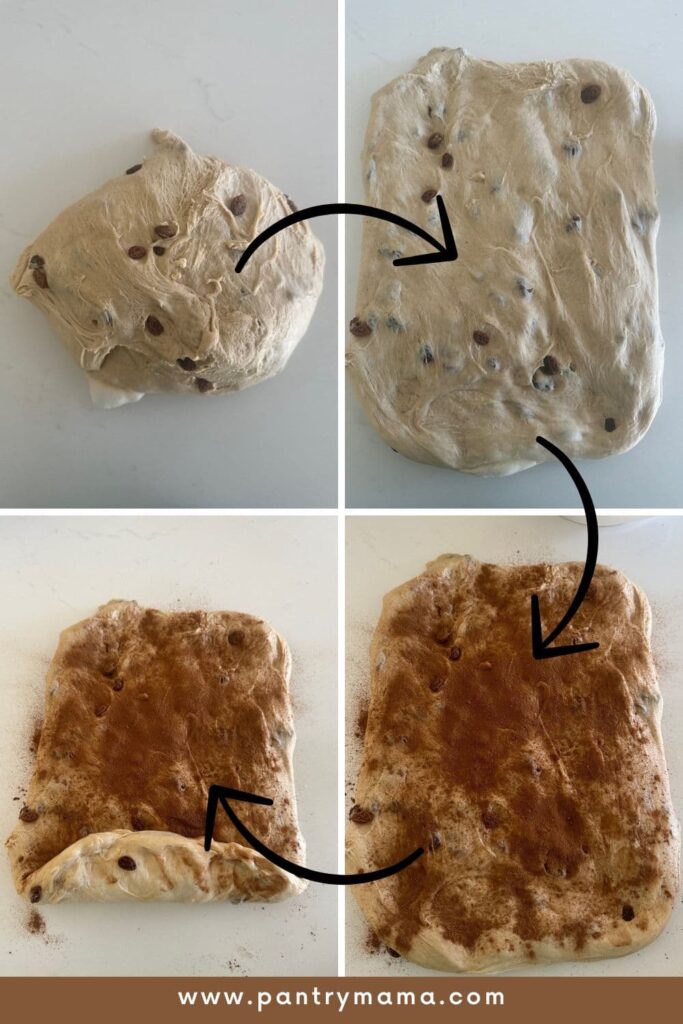
Sprinkle the dough with cinnamon so that it is evenly covered.
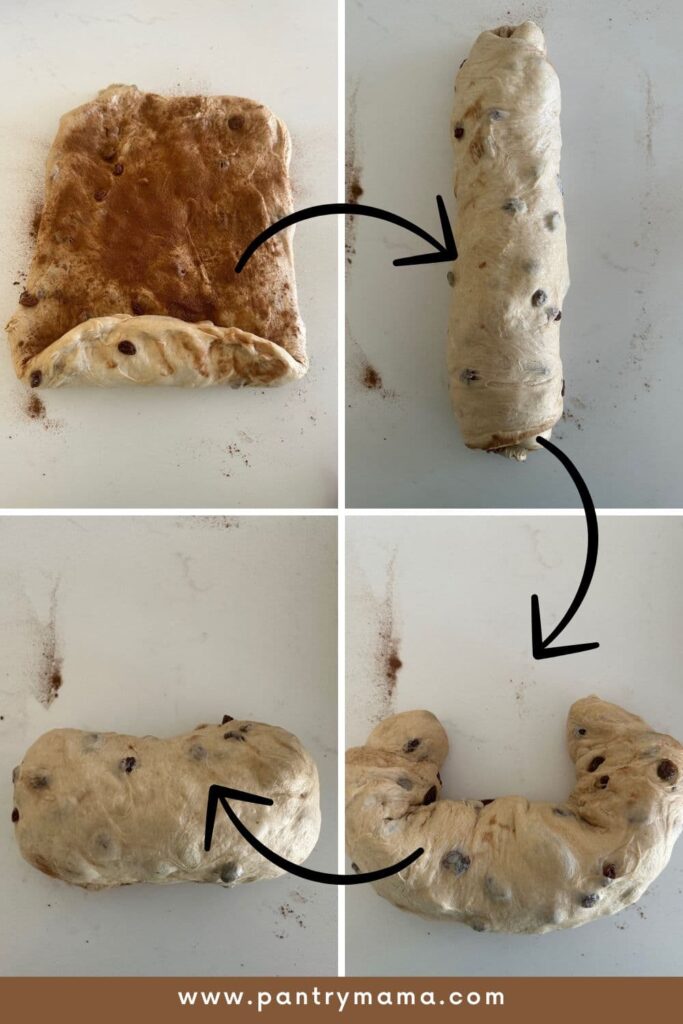
Roll the dough up into a log and tuck the ends under. Place the dough into an oiled sandwich loaf tin and gently press it down so that it fills up the base of the tin. Place a plastic food cover back onto the pan and leave it to rise up and get nice and puffy. Ideally, you want it to just peak above the rim of the pan before you bake it.
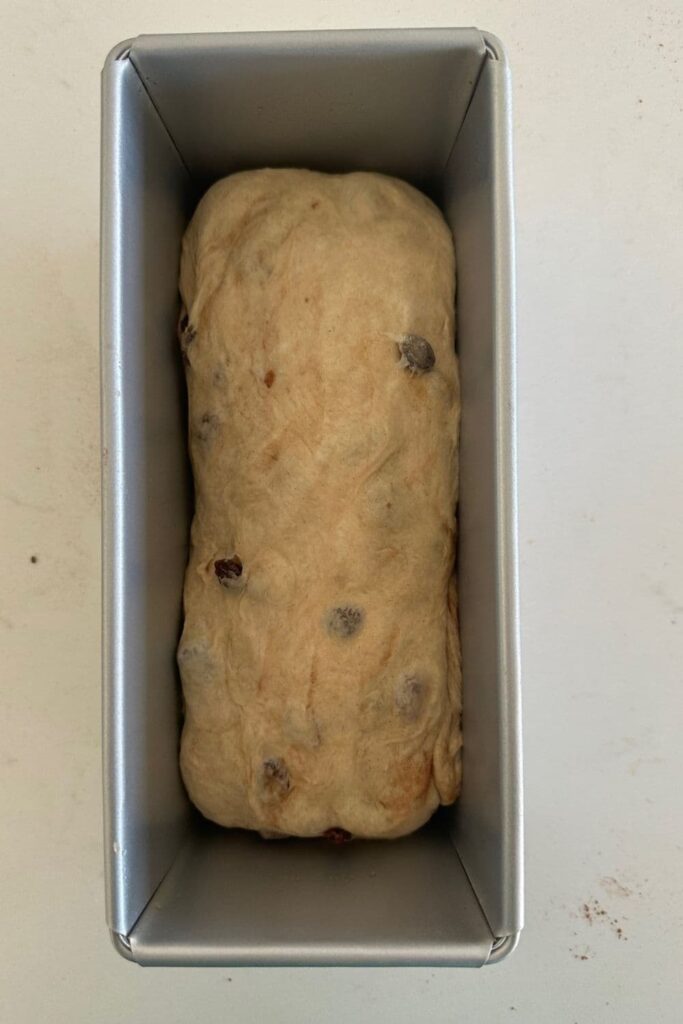

Let's Bake!
Once the dough has risen, you'll need to bake your loaf. Turn your oven on and set the temperature to 180C/350F.Lightly egg wash the top of the dough.
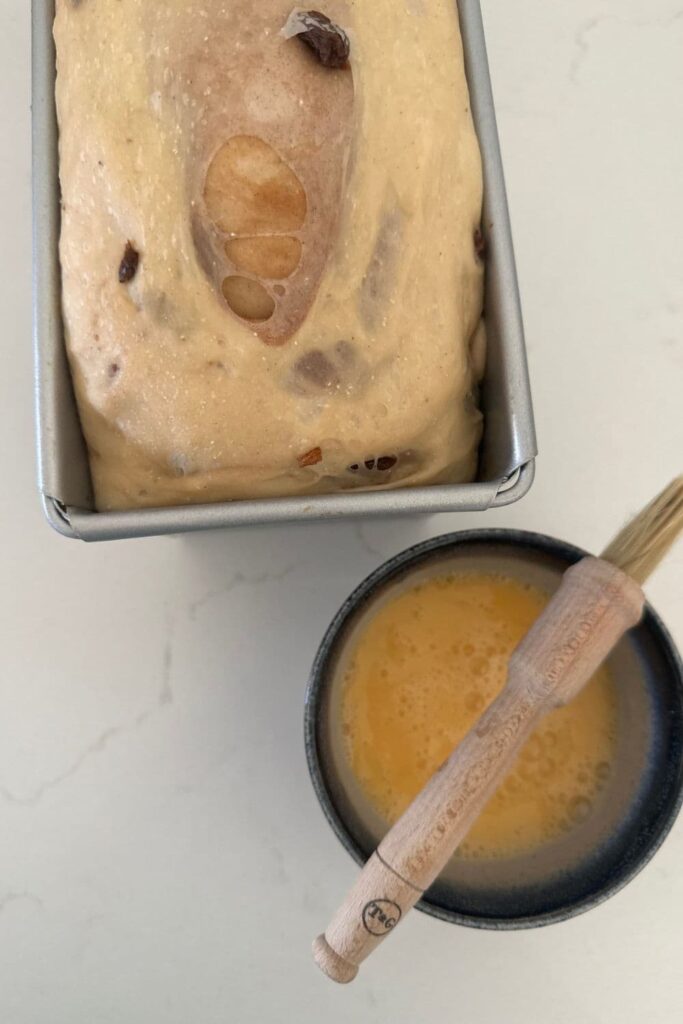
Bake your bread at 180C/350F for around 40 to 45 minutes or until the loaf is golden brown. I like putting this loaf on a lower rack in the oven. Just watch the top as the egg wash is prone to getting dark quite quickly.
Remove from the loaf tin and allow to cool on a wire rack.
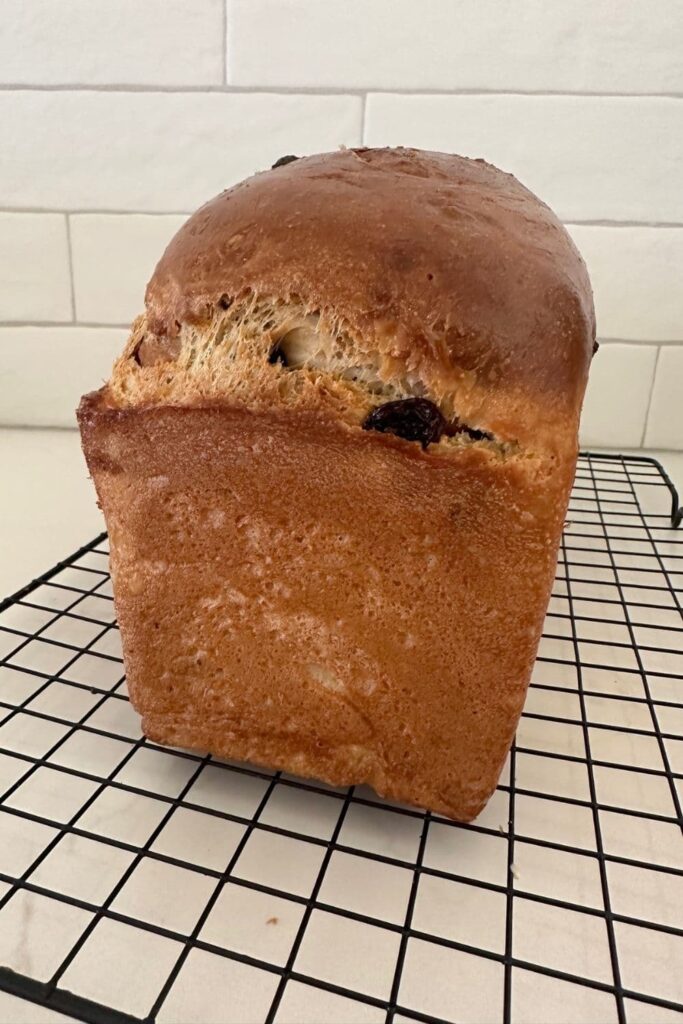
How To Use A Stand Mixer For This Recipe
I have provided instructions for kneading by hand above, however you can easily make this recipe in a stand mixer (it's actually easier!).
Add the ingredients to the bowl in the order shown on the recipe card, but when it gets to kneading, use the dough hook on your stand mixer.
You can add the butter and the raisins at the same time.
Knead the dough in 2 minute increments, with a small rest after each 2 minutes until the dough is soft and elastic and doesn't stick to the sides of the bowl.
You can also make this recipe in a Thermomix using the knead function. It takes around 5 minutes for the dough to be sufficiently kneaded and the raisins incorporated.
You can read more about using a stand mixer for sourdough bread here.
Secret To Better Color Crumb
While this recipe works perfectly as it is, I love adding 2g of Dark Malt Powder to my bread flour to give this sourdough loaf a warm, "cinnamony" hue.
Because we don't actually add the cinnamon to the dough itself, the bread doesn't really take on the color of the cinnamon. Adding just a little dark malt powder can give you the color of cafe style cinnamon raisin toast.
Dark malt powder is not necessary for the recipe to be successful, you can leave it out if you don't have it.
What Bread Pan To Use For This Recipe?
I have used a non stick bread pan for this recipe. It measures 270mm (L) x 110mm (W) x 110mm (H) and can hold 2.8 liters. This converts to 10.6" (L) x 4.3" (W) x 4.3" (H). I purchased this tin from here.
I have not used the lid when baking this sourdough discard cinnamon raisin loaf as I prefer the rounded top on my loaf for a more farmhouse feel.
I have found bread pans with similar measurements on Amazon. These are the closest in size to the pan I have used:
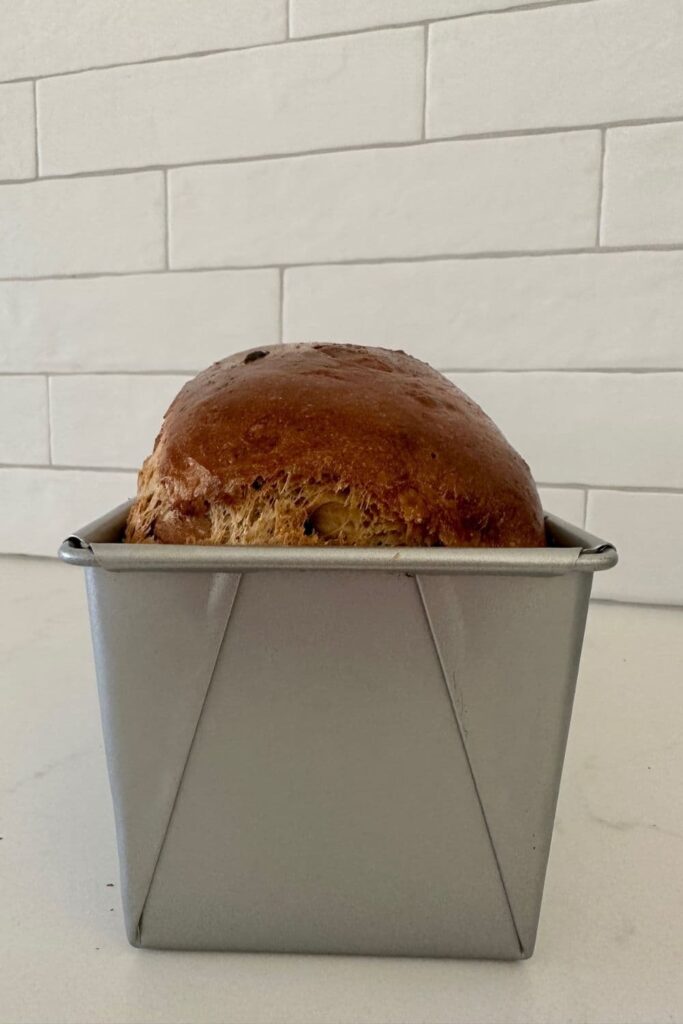
Baker's Timelines (for Discard and Active Starter)
I have provided two different sample timelines for this loaf of sourdough discard cinnamon raisin bread. You can change these to best suit your own schedule. You might also find this post on creating a sourdough baking timeline helpful.
Sourdough Discard + Yeast
Using discard + yeast for this sourdough cinnamon raisin bread makes it fairly quick to make. You can of course reduce the amount of added yeast to prolong the rise time if you wish. Here's the approximate timeline I use when making this loaf with discard plus added yeast:
4pm - Take discard out of the fridge and let it out while I organise other necessary ingredients.
5pm - Initial mix of dough.
5.30pm - Knead the butter and raisins into the dough.
5.45pm - Allow dough to double at room temp for around an hour (this might take longer if your house is cooler).
7pm - Sprinkle dough with cinnamon, shape and place into sandwich loaf pan. Leave dough to proof and double in size again.
9pm - Bake Sourdough Discard Cinnamon Raisin Loaf for 40 minutes. Allow to cool overnight so we can enjoy for breakfast tomorrow.
Active Sourdough Starter with No Yeast
If you have a mature starter and would prefer to keep this loaf as true sourdough, then you can just add 100g of active starter instead of discard and skip the yeast. This is the approximate timeline I use when making this loaf with no added commercial yeast:
THE NIGHT BEFORE
9pm - Feed sourdough starter so it's ready to go first thing tomorrow (I generally feed 1:2:2 or 1:3:3 to make it peak in the morning).
IN THE MORNING
7am - Initial mix of dough using active sourdough starter.
8am - Knead the butter and raisins into the dough.
8.15am - Set the dough aside for bulk fermentation at room temperature. You want the dough to be just under double when using active sourdough starter.
4pm - Sprinkle dough with cinnamon, shape and place into sandwich loaf pan. Leave dough to proof at room temperature. You want the dough to be peaking over the lip of the bread pan.
10pm - Bake Sourdough Discard Cinnamon Raisin Loaf for 40 minutes. Allow to cool overnight so we can enjoy for breakfast tomorrow. Alternatively you could place into the fridge at this point and bake in the morning.
Perfect Spreads for Sourdough Cinnamon Raisin Bread
This sourdough cinnamon raisin bread is just begging to be spread with something delicious. Whether you like to eat it toasted or fresh, there's bound to be something here that you'll love to try next time you bake a loaf:
- Cultured Butter
- Homemade Butter
- Whipped Cinnamon Honey Butter
- Spiced Pumpkin Cream Cheese
- Fig Cream Cheese Spread
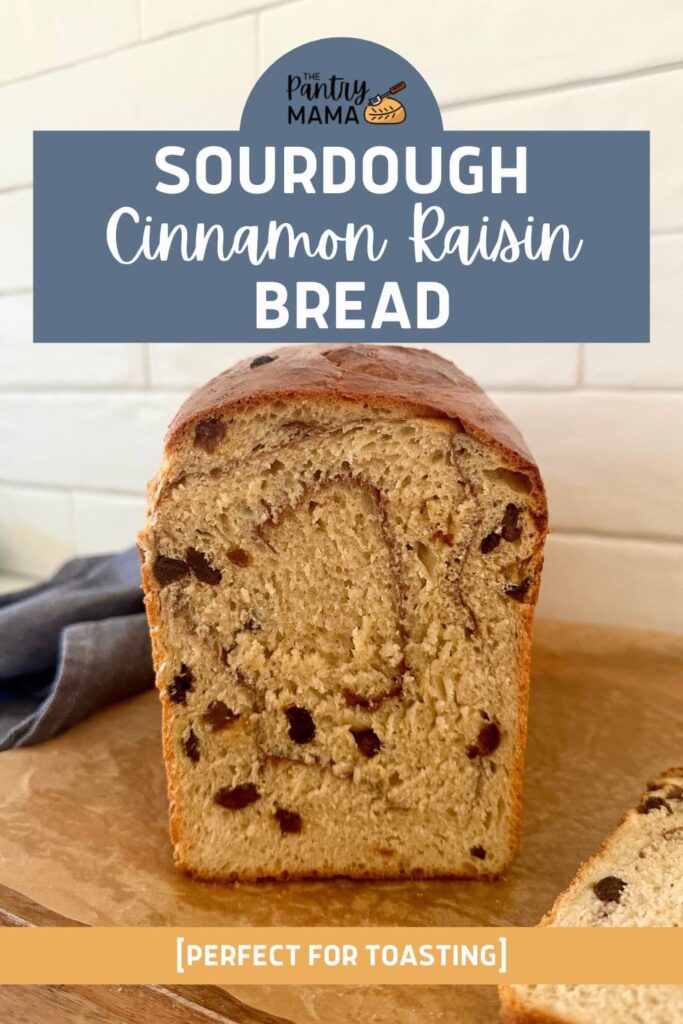
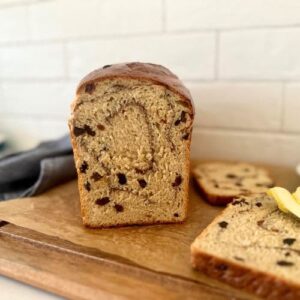
Sourdough Cinnamon Raisin Bread
Equipment
- Stand Mixer
- Digital Scales
- Bread Tin
Ingredients
- 100 g Sourdough Discard (unfed sourdough starter - or see notes for using active sourdough starter)
- 300 g Water
- 1 Egg
- 60 g Brown Sugar
- 5 g Yeast (instant or active dry yeast is fine - or see notes for using active sourdough starter)
- 550 g Bread Flour
- 10 g Salt
- 40 g Butter (softened at room temperature)
- 100 g Raisins (increase to 150g if you want heavy raisins)
- 5 g Cinnamon (approx. 2 teaspoons)
Instructions
- I have written these instructions to make the dough by hand. It is a sticky dough when you add the butter, but it's totally doable by hand. You can definitely use a stand mixer if you prefer (I've added notes for this at the bottom of the recipe card).
- In a large bowl, whisk together sourdough discard, water, egg and brown sugar. Once it's well combined, add the yeast to the liquid and stir through.
- Now add the bread flour and salt to the bowl and bring this together into a shaggy dough. Allow this to sit for around 30 minutes.
- Once the dough has been sitting for 30 minutes, tip it onto the counter and add a little of the soft butter on top of the shaggy dough. Knead the dough until the butter has been distributed through, then add a little more butter until all the butter has been added. Don't worry if the dough feels slimy or too sticky. Keep kneading. This dough is similar to a brioche dough in that it will get quite unworkable until you really push the butter into the dough. All of a sudden if will come together.
- Once the butter has all been added, sprinkle the raisins through the dough as you continue to knead.
- The dough will take around 10 minutes to knead by hand and will become silky and elastic.
- Once the dough has been sufficiently kneaded, place it into a bowl and cover with a plastic food cover. Allow the dough to double in the bowl before moving onto the next step.Because we've added a little commercial yeast, this won't take too long (I've added notes below in case you don't want to use yeast and want to use your active starter instead).
- Once the dough has doubled, tip it out onto the counter top with the smooth side underneath and the sticky side on the top. Gently ease the dough out into a rectangle. It should be quite easy to do this as the dough is very elastic.
- Sprinkle the dough with cinnamon so that it is evenly covered.
- Roll the dough up into a log and tuck the ends under. Place the dough into an oiled sandwich loaf tin and gently press it down so that it fills up the base of the tin. Place a plastic food cover back onto the pan and leave it to rise up and get nice and puffy. Ideally, you want it to just peak above the rim of the pan before you bake it.
- Once the dough has risen, you'll need to bake your loaf. Turn your oven on and set the temperature to 180C/350F. Lightly egg wash the top of the dough.
- Bake your bread at 180C/350F for around 40 to 45 minutes or until the loaf is golden brown. I like putting this loaf on a lower rack in the oven. Just watch the top as the egg wash is prone to getting dark quite quickly.
- Remove from the loaf tin and allow to cool on a wire rack.
Notes
Nutrition

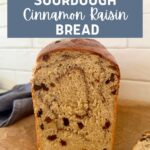
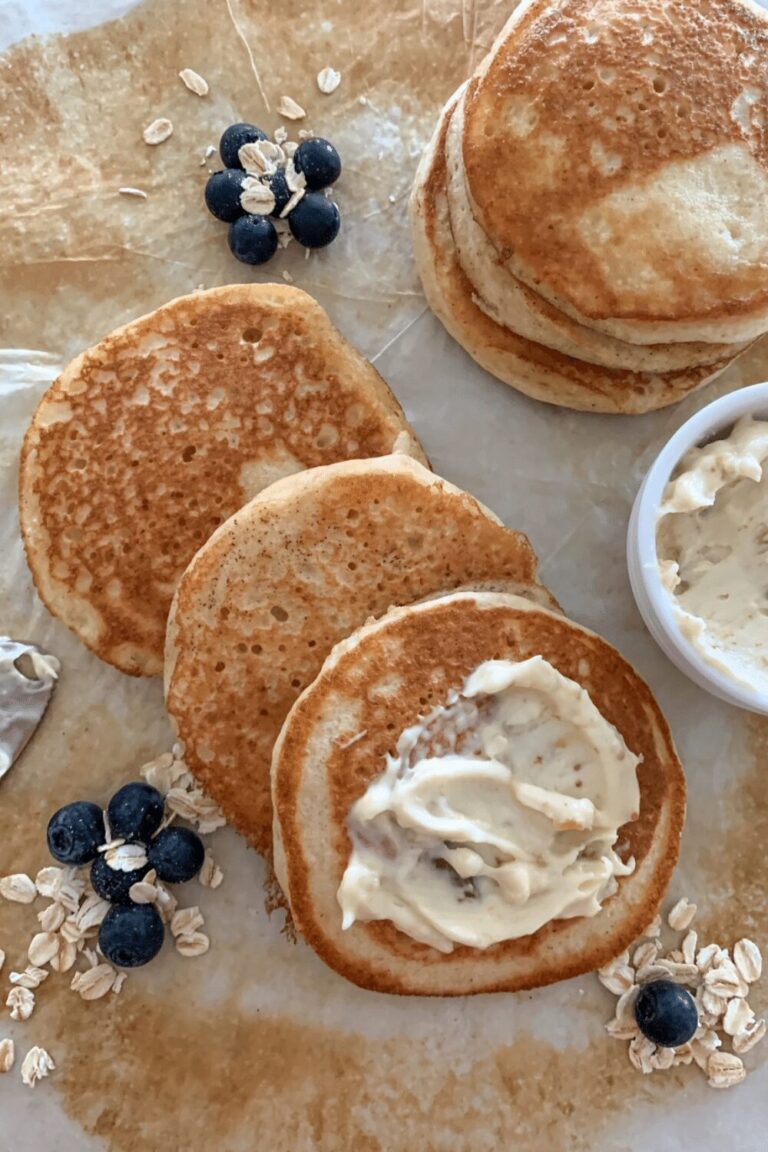
![Sourdough Pumpkin Grissini [sourdough breadsticks]](https://www.pantrymama.com/wp-content/uploads/2021/06/SOURDOUGH-PUMPKIN-GRISSINI-1-768x1152.jpg)
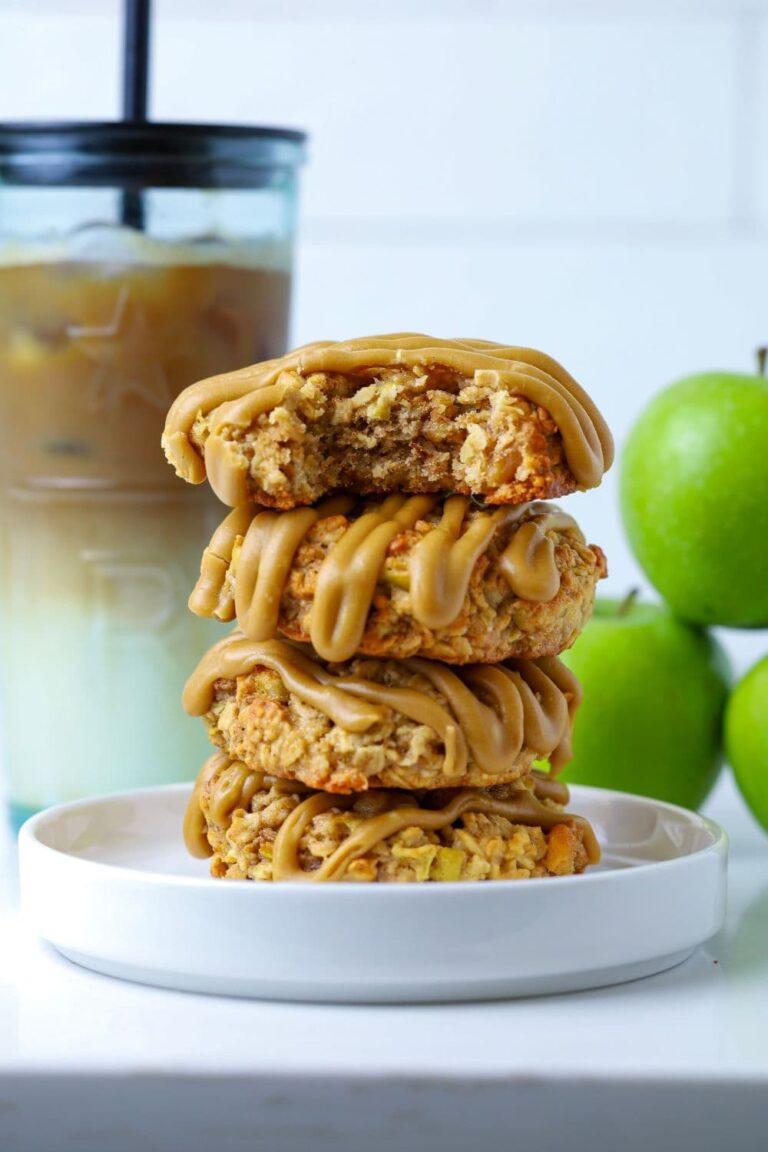


Can I use all purpose flour?
I made this and it’s delicious!!! I did struggle to get the dough to come together after adding the butter even though I was using a mixer. It did end up being sticky after bulk fermentation so I had to flour my bench and hands. Still it turned out great!!! I’m going to make another loaf.
My rough never pulled away from the bowl even with mixer. I even did it longer than 10 minutes but it never changed textures. Super sticky! I left it in bowl and I am on hour 2 and it still hasn’t doubled but I followed the recipe completely. Going to give it another hour to rise so I can shape but something isn’t right. I put the yeast in but it’s not rising.
This was pretty easy and turned out soooo good. The dough was a bit sticky and took a long time to hand knead and come together, but it was definitely worth it. Big hit with the family..
Where are the notes for not using commercial yeast?
I love this bread! Made it a few times now and I have a question, when rolling into a log it is not very workable and doesn’t hold shape well. Rises fine in loaf pan and bakes fine but am I doing something wrong?
Made this once and it was sooo good. Making it again now. Thank you!!!
Yay! So glad you love the recipe, thank you for commenting 🙂
Delicious! I used olive oil instead of the butter due to health reasons. It still turned out delicious!
If you are using a mixer do you get the dough sit for 30 minutes before adding better and raisins. It's unclear.
I will never buy store bought cinnamon raisin bread again. This recipe was so easy and delicious. I will make several loaves next time and freeze them. Looking forward to trying other recipes on your site. Hugs.
Third time making this today, we just love this bread toasted.
I find adding the malt powder makes it rise quicker, will never buy Raisin bread again.
Thanks you for the recipe.
Great recipe!
Just made 3 loaves today.
I was unable to attach picture to this but they look as good as they taste!
Crumpets are next!
Thanks for the great recipes!
I’ve just started visiting your site after starting my sourdough adventure about 6 weeks ago. I made the Sourdough Cinnamon Bread today with some of my discard. I have made a lot of no knead bread, but not this kind of soft dough with butter. I used my stand mixer and was afraid I might have overworked the dough. It was sticky and not coming off the sides of the bowl. My intuition told me to let it rest/proof and it rose beautifully in about 2 1/2 hours. After shaping it in the pan, it rose further and I knew it was going to work. It was absolutely divine with golden raisins. Perfection! This is a keeper and I am eager to try more of your recipes. Thank you!
Can't wait to try this (I love all your recipes so far!), but what's an alternative to this huge pan? I live alone and just don't have a need for such a large pan, plus I have so many nice pans and I really can't store any more. Would this amount of dough fit in two 8.5 x 4.5 pans? I also have two 7.75 x 3.75 and two 9 x 5s as well as two 9 x 4 x 4 pullman pans. I can't figure out the math, lol!
Was a little intimidated by the sticky ness my first loaf but it did come together nicely, and turned out perfect ..I've made 6 loaves so far for us amd the neighbors over the last couple weeks we love it...making 2 more now
I made your raisin bread. It was absolutely divine. My hubby asked me to please make more the next day. Had to share it with my grandson who is 22 months. He literally ate a whole slice..
I have made this several times now I love it I use 75g raisins and 75g cranberries and it is absolutely the best bread I have made several of your recipes several times you have defenitly made otherwise hard to make very easy thank you 😊
Hi i baked this recipe yesterday very 1st time baking in a loaf pan with sourdough. I struggled getting the right smooth consistency it was quite wet even after rising and turning out. It still came out great, i live in the UK and it tasted just like a British tea cake i brushed a simple syrup on the top after baking which made it more like the tea cake. Yummy will definitely try this again.
Just Made A Loaf! 100/100 Thank you for this Delicious Recipe! I posted on my instagram! @therealmerceshanehouse
I would love some standard measurements as well. I love your recipes and find I spend 30 minutes figuring out Standard measurements with every single recipe.
I'm also wondering why you don't ever include rise times. How long should we be leaving it to rise each time?
Hi Victoria, Using weighted measurements is much more accurate and easier. This post on why we use weighted measurements with sourdough may clarify a bit more.
As for rise times - it depends on so many factors unique to you and your sourdough starter, so Kate always suggests to watch your dough rather than the clock. 🙂
Was surprised how good this came out. Used a clay cooker with lid. Cooked at 425 for 30 minutes then with lid off 375 for 15 minutes. Lid soaked in water before baking and the steam I think made very good bread. Thank you for recipe. Will definitely make again.
Fall is my FAVORITE season! I made this bread with some leftover apple cider instead of water. It was AMAZING!!! The bread came out perfectly! Of course, I stuck my welders-gloved thumb into it as I took it out of the pan...Had to cut a slice to hide it!!! 🙃 Have another one rising on the counter. Wish i could share yesterday's picture of my dough escaping from its bowl! Thank you so very much for your great recipes! I am forever a fan!!!
Haha! Sounds delicious! I love that!
I have been making this regularly for a while now and I have never had a failure. I do put more raisins in and it’s absolutely lovely toasted.
Thank you for the recipe.
I made this in my mixer for the first time and it’s absolutely delicious! I’m so happy I found you and these discard recipes. It’s so much fun!
Can you make this dough into cinnamon rolls?
It wouldn't be quite the same as typical cinnamon rolls, but we have this sourdough cinnamon roll recipe and this one that are delicious. 🙂
What would happen if one used active starter just past its peak and say 2-3g yeast, cold-fermented overnight after kneading? I like makng my doughs in the evening and baking next morning but sometimes I miss my starter’s peak…wondering how I can overnight this one without over proofing basically, lol
Thank you!
I used Munk fruit and or Date Syrup to replace the regular sugar and the result is always a wonderful beautiful delicious bread, thank you!!!
Great sugar substitutions, Maria. Thank you so much!
Add the rind and juice of an orange (just reduce the amount of water by the amount of juice you add). Amazing addition!
Oh that sounds delicious! Thank you for sharing, Nathan 🙂
Does it need to be in a bread pan? Can I bake it like I do in the dutch over like with my regular sourdough discard bread?
You could try, I have only baked this one in a loaf pan 🙂